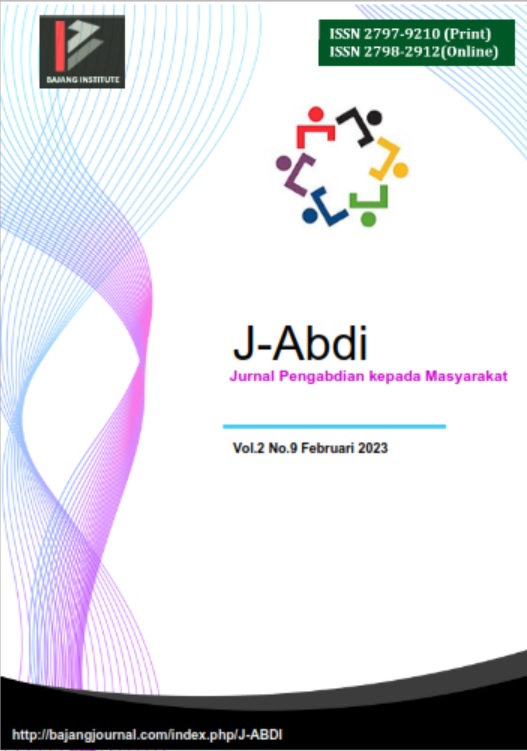PENINGKATAN PENGETAHUAN TENTANG MPASI DAN PICKY EATER PADA IBU BAYI DAN BALITA DI DESA MADEGONDO
DOI:
https://doi.org/10.53625/jabdi.v2i9.4866Keywords:
Balita, MPASI, Picky EaterAbstract
Toddlers are often faced with eating disorders such as picky eaters. A picky eater is a condition where children like to be picky and less responsive to food. This condition will have adverse nutritional impacts in the future, such as growth disorders, developmental disorders, and metabolic disorders. One of the factors that cause picky eaters is giving complementary foods too early and also not in accordance with the principles of balanced nutrition. The community service method is carried out using counseling about giving good and correct complementary foods as well as tips for dealing with children who have picky eating disorders. This activity aims to make mothers of infants and toddlers knowledgeable and also aware of the nutrition for their children. This activity received a good response from the midwife, integrated service post (posyandu) cadres, and also mothers of infants and toddlers, as evidenced by the many questions and discussions.
References
Cerdasari C, Helmyati S, Julia M. 2017. Tekanan Untuk Makan Dengan Kejadian Picky Eater Pada Anak Usia 2- 3 Tahun. Jurnal Gizi Klinik Indonesia;13: 170–78.
Chao HC, Chang HL. 2017. Picky Eating Behaviors Linked to Inappropriate Caregiver Child Interaction, Caregiver Intervention, and Impaired General Development in Children. Pediatrics and Neonatology;58 (1): 22–28. doi:10.1016/j.pedneo.2015.11.008
Dulal B, Mundy G, Sawal R, Rana PP, Cunningham K. 2017. Homestead Food Production and Maternal and Child Dietary Diversity in Nepal: Variations in Association by Season and Agroecological Zone. Food Nutr Bull; 38(3): p. 338-353.
Kesuma A, Novayelinda R, Sabrian F. 2016. Faktor-Faktor Yang Berhubungan dengan Perilaku Kesulitan Makan Anak Pra Sekolah. Universitas Riau. Jurnal Online Mahasiswa (JOM) Bidang Kedokteran; 2 (2): 953 – 961.
Khaq AE, Yuniastuti A, Rahayu SR. 2018. An Analysis of Picky Eater Towards Growth and Motor Development at kebasen District health Centre. Public health Perspevtives Journal; 3(3): p-ISSN 2528-5998.
Kim SS, Nguyen PH, Tran LM, Sanghvi T, Mahmud Z, Haque MR, Afsana K, et al. 2018. Large-Scale Social and Behavior Change Communication Interventions Have Sustained Impacts on Infant and Young Child Feeding Knowledge and Practices: Results of a 2-Year Follow-Up Study in Bangladesh. J Nutr; 148(10): p. 1605-1614.
Locks LM, Dahal P, Pokharel R, Joshi N, Paudyal N, Whitehead RD, Chitekwe S, et al. 2018. Infant and Young Child Feeding (IYCF) Practices Improved in 2 Districts in Nepal during the Scale-Up of an Integrated IYCF and Micronutrient Powder Program. Curr Dev Nutr; 2(6): p. nzy019.
Maingi M, Kimiywe J, Iron-Segev S. Effectiveness of Baby Friendly Community Initiative (BFCI) on complementary feeding in Koibatek, Kenya: a randomized control study. 2018. BMC Public Health; 18(1): p. 600.
Nikiema L, Huybregts L, Martin-Prevel Y, Donnen P, Lanou H, Grosemans J, Offoh P, et al.2017. Effectiveness of facility-based personalized maternal nutrition counseling in improving child growth and morbidity up to 18 months: A cluster-randomized controlled trial in rural Burkina Faso. PLoS One; 12(5): p. e0177839.
Nordhagen S, Klemm, R. 2018. Implementing small-scale poultryfor-nutrition projects: Successes and lessons learned. Matern Child Nutr; 14 Suppl 3: p. e12676.
United Nations Children’s Fund (UNICEF). 2020. Improving Young Children’s
Diets During the Complementary Feeding Period. UNICEF Programming Guidance. New York: UNICEF.















